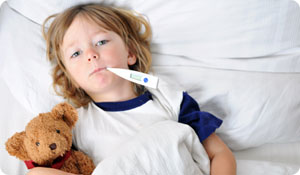
Most families know that back-to-school time also means back-to-doctor time. That's because, when kids crowd onto school busses and into classrooms, they're exposed to lots of new germs. Here are some of the most common ailments:
1) The common cold. On average, children catch between six and eight colds per year and each time, they spend a week or two with a runny nose, coughing, sore throat, chest congestion sneezing, and mild aches and pains.
They'll catch fewer as they get older, but the best way to avoid them is to teach kids to wash their hands and avoid touching their nose and eyes. Also, have your child bring her own box of tissues to school to avoid touching the germy classroom box.
2) Head lice. It's common, creepy, and largely preventable. Head lice is a tiny bug that lives on the scalp and spreads easily from person-to-person through direct contact with an infected person's hair, brush, coat, hat, or anything else that comes in contact with lice. It's especially common when kids share lockers or hair supplies, hang jackets close together, or lie on carpets and pillows together.
Teach your child to never share anything that touches his or another child's head. If he shares a locker, have him place his jacket in a plastic bag before he hangs it up. Inspect hair frequently for lice and nits (lice eggs that look like white specks and cling to the base of a hair shaft), and contact your pediatrician for advice on how to get rid of it.
3) Pink eye (conjunctivitis). This highly contagious eye infection causes the clear lining of the eyeball to become inflamed, red, itchy, and sticky. Pink eye is often caused by a viral infection, which heals on its own within a few days. Sometimes, it's caused by a bacterial infection, which can be treated with antibiotic eye drops prescribed by your doctor.
Teach your child to avoid touching his eyes and to wash his hands frequently.
4) Strep throat. Caused by Group A Streptococcus bacteria, this is the most common bacterial throat infection. Symptoms usually start within two to five days after exposure and might include a severe sore throat, fever, red throat with white patches, chills, aches and pains, fatigue, and rash.
Your child's doctor can take a swab sample of the throat and do a rapid culture in her office, which often diagnoses it in less than a half hour. If the fast test is negative, your doctor will culture the sample for a few days to make sure strep doesn't grow. If the fast test or culture is positive, she'll prescribe antibiotics and your child can usually go back to school within a couple of days.
5) Hand, foot and mouth disease. This is a common viral illness that usually affects infants and children younger than 5 years old. Symptoms include fever, blister-like sores in the mouth, and a skin rash.
There's no specific treatment for this virus, which clears up on its own within a week or two. The best way to prevent catching it is with frequent, thorough hand washing. And be sure to keep your child home from school until her symptoms are all clear.
6) The flu. Influenza is a contagious viral respiratory infection that causes mild to severe symptoms and in rare cases, can even cause death. Symptoms include fever, cough, sore throat, runny nose, body aches and pains, extreme fatigue, severe headache and in some (but not most) cases, vomiting and diarrhea.
The best way to avoid getting the flu is with an annual flu vaccine. Once a person has flu symptoms, it's important to see a doctor immediately. An early diagnosis and prescription for anti-viral medications like Tamiflu can sometimes cut the duration and severity of the flu significantly.
If your child comes home with a bug, check in with your doctor and keep her home until she's no longer contagious.





